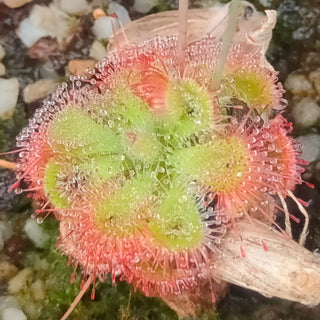Shepherdia argentea
SILVER BUFFALOBERRY
- Unit price
- / per
Shepherdia argentea, commonly called silver buffaloberry, bull berry, or thorny buffaloberry, is native to the western and central parts of Canada and North America. It grows in many different kinds of habitats such as riparian areas, woodlands, exposed slopes on prairies, and in dry, sandy soils of plains and canyons.
Shepherdia argentea is a deciduous shrub growing from 2-6 metres (6.6-19.7 ft) tall. The leaves are green with a covering of fine silvery, silky hairs, giving it a silver-gray appearance.
The flowers are pale yellow, with four sepals but no petals.
The fruit is a bright red fleshy drupe 5 mm in diameter; it is edible with a slightly bitter taste. In the Great Basin, the berries were eaten raw and dried for winter use, but more often cooked into a flavoring sauce for bison meat. The buffaloberry has been a staple food to some Native Americans, who ate the berries in puddings, jellies, and in raw or dried form.
Type: Hardy shrub
Hardiness zones: 2-9
Location: Sun or part shade
Height: 12', 3.5m
Seeds per packet: 3
Pour hot water over seed and then let stand in water for 6-12 hours. Then plant the seeds just under the surface of the soil. Then cover them with plastic and place in a fridge for 60-90 days. Be sure they stay moist. After the cold stratification period they are then brought back to room temperature 20-22°C (68-72°F) for them to germinate. Germination is generally 30-90 days after the warming period, though some can take longer.
Shepherdia argentea
SILVER BUFFALOBERRY
- Unit price
- / per
Multiple secure payment options available.
Adding product to your cart
You may also like
Shepherdia argentea, commonly called silver buffaloberry, bull berry, or thorny buffaloberry, is native to the western and central parts of Canada and North America. It grows in many different kinds of habitats such as riparian areas, woodlands, exposed slopes on prairies, and in dry, sandy soils of plains and canyons.
Shepherdia argentea is a deciduous shrub growing from 2-6 metres (6.6-19.7 ft) tall. The leaves are green with a covering of fine silvery, silky hairs, giving it a silver-gray appearance.
The flowers are pale yellow, with four sepals but no petals.
The fruit is a bright red fleshy drupe 5 mm in diameter; it is edible with a slightly bitter taste. In the Great Basin, the berries were eaten raw and dried for winter use, but more often cooked into a flavoring sauce for bison meat. The buffaloberry has been a staple food to some Native Americans, who ate the berries in puddings, jellies, and in raw or dried form.
Type: Hardy shrub
Hardiness zones: 2-9
Location: Sun or part shade
Height: 12', 3.5m
Seeds per packet: 3
Pour hot water over seed and then let stand in water for 6-12 hours. Then plant the seeds just under the surface of the soil. Then cover them with plastic and place in a fridge for 60-90 days. Be sure they stay moist. After the cold stratification period they are then brought back to room temperature 20-22°C (68-72°F) for them to germinate. Germination is generally 30-90 days after the warming period, though some can take longer.
















































